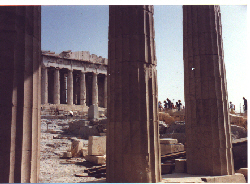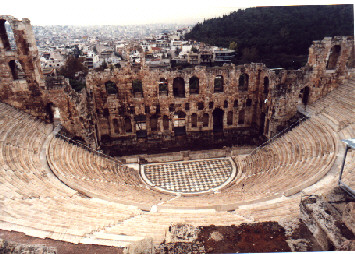|
The Parthenon (built
between 458 & 447 BC)
The Parthenon, the temple
of Athena Parthenos, or Virgin Athena, designed by
the architects Iktinos and Kallikrates, represents
the climax of the Doric style and incorporated
sophisticated architectural refinements and the sublime
sculptures by Phideasand his school. The temple to
Zeus at Olympia had been completed 10 years earlier and
Perikles wanted a temple that was even bigger and better,
a symbol of Athens' superiority and a monument to
victory and revenge. There was to be no compromise; this
was to be the ultimate in innovation.
The
design is of superb quality, the apparently simple lines
concealing geometric complexities. There are 8 Doric
columns, rather than the more usual 6, at each end
and 17 on each side, giving a proportion of
9:4, a ratio repeated throughout the building.
The
entire temple, except the roof, was constructed in white Pentelic
marble, brought by 2,500 slaves from Mount Pentellus,
10 miles away. Some 180,000 tons of marble were removed
from the quarry, each 40 ton block taking 10 men 10 days
to move. They used sledges on slipways to get the blocks
down from the quarries and carts drawn by 30 or 40 oxen
to take them to the acropolis. The roof was made of
Parian marble which is whiter and could be cut more
thinly making it lighter and translucent.
The
platform, stylobate, on which the temple rests is
11 centimetres higher in the centre to make it look flat,
and the columns have a slight bulging (entasis),
which actually results in them looking straight. There is
in fact not a straight line anywhere.
The
naos, or cella, housed Phideas' majestic,
if 'over the top', 10 metres high chryselephantine
(gold and ivory), statue of Athena, clothed in
over a ton of gold, worth in today's money £8 million!
The temple faces east so that the rising sun would light
the statue and reveal its full glory. The statue has been
lost since ancient times but representations on coins and
Roman copies give us an idea of what it looked like.
Around
the back and sides of the naos there was a two storey
colonnade,above which was a continuous frieze,
(1 metre high and 160 metres long), of wonderful low
relief sculptures, which would have been brightly
coloured, depicting the Panathenaic procession. The
procession, which started at the Keraméikon and ended at
the Eréchtheion, was the culmination of a major Athenian
religious festival held every four years to celebrate the
birthday of the goddess, when the Athenians offered a new
dress (peplos) to the goddess. (It was not used to
drape the statue in the Parthenon, but the much smaller
one made of olive wood in the Eréchthion).
Taking
part in the procession were youths and maidens, priests,
riders and horses, chariots, and animals being led to
sacrifice; the frieze depicts 360 human and 250 animal
figures in total.
The sculptures of the east
pediment showed the birth of Athena(you'll
remember she was released from the head of Zeus with the
aid of Hephaistos' axe!) with all the gods and goddesses
in attendance. Those on the west pediment showed the struggle
between Athena and Poseidon for Attika.
The
92 metopes (the Greek word for
forehead), each one sculpted, depicted mythical
battles (Lapiths and centaurs, Amazons, gods and
giants, and Trojans). They were carved by several
different craftsmen and the quality varies considerably.
There is only one metope still in place on the south
side; it gives you an idea of the distance they were seen
from. The detail was for the eyes of the gods rather than
people.
Lion
head gargoyles which drained water from the roof
remain on the north-east and north-west corners but the
statue on the north front pediment is a reproduction.
Regrettably
most of the frieze and pediment sculptures were taken by
Elgin and are now in the British Museum. If you haven't
already been, do go and see them, they are so splendid.
|


